 Patellar tendonitis (“Jumper’s Knee”) is a frustrating knee injury that can last for years. This article will show how to cut the recovery time down to just a few weeks.
Patellar tendonitis (“Jumper’s Knee”) is a frustrating knee injury that can last for years. This article will show how to cut the recovery time down to just a few weeks.
Patellar tendonitis is an injury of the tendon that connects the kneecap (“patella”) to the shinbone. You need the patellar tendon to produce knee extension.
Every time you run or jump the patellar tendon gets put to work. This is why “jumper’s knee” is common in sports that require explosive leg movements such as volleyball or basketball, but it can also occur in non-athletes.
This page will tell you how to get rid of tendonitis as fast as possible, based on current academic research.
Before continuing, read the full disclaimer here.
Signs & Symptoms
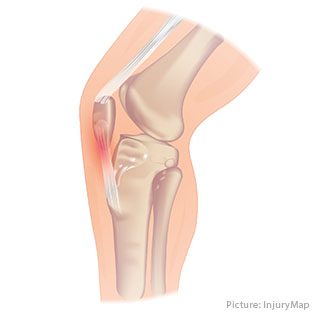 In patellar tendonitis the pain will be on the front of the knee. It can be located where the patellar tendon connects to the kneecap or to the shinbone.
In patellar tendonitis the pain will be on the front of the knee. It can be located where the patellar tendon connects to the kneecap or to the shinbone.
Usually activities such as running, jumping, or squatting will make the pain worse. The pain response can be immediate, but it can also be delayed by up to 48 hours. Even sitting can be painful.
“Jumper’s Knee” progresses in stages. Early on you may only feel pain after intense training sessions, but as the injury gets more chronic, you may also begin to feel it during sports and even while at rest.

Your injury is not patellar tendonitis if your pain is:
- On the side of the knee
- Above the knee
- Behind the knee
- Inside the actual knee joint
Your doctor can use imaging technologies such as ultrasound or MRI to rule out other injuries via differential diagnosis.
Warning:
Go to a doctor right away if…
- The joint is swollen or discolored
- The pain is very sharp or is getting worse
- You cannot do everyday activities
- The knee feels unstable
- There is a locking feeling in the knee
- You cannot put weight on the leg
Please take this seriously. Ignoring the pain can cause bigger problems down the road.
Causes & Risk Factors
Patellar tendonitis can be caused by a blow to the tendon1 or by certain antibiotics, but by far the most common cause is continued overuse of the tendon.
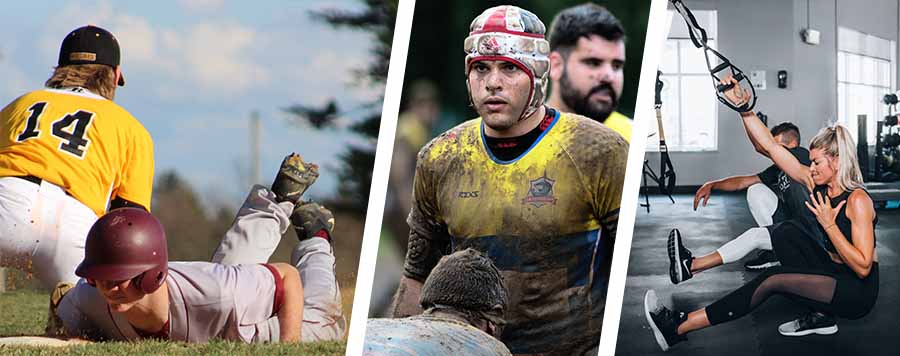
This overuse can happen in one single training session or sports event, like say a weekend tournament, or by exceeding the tendon’s load tolerance over a longer period of time.
The most common example is training too hard and too frequently. This repeated overuse prevents the tendon’s adaptation response and instead of getting stronger, cellular changes inside the tendon slowly make it weaker2.
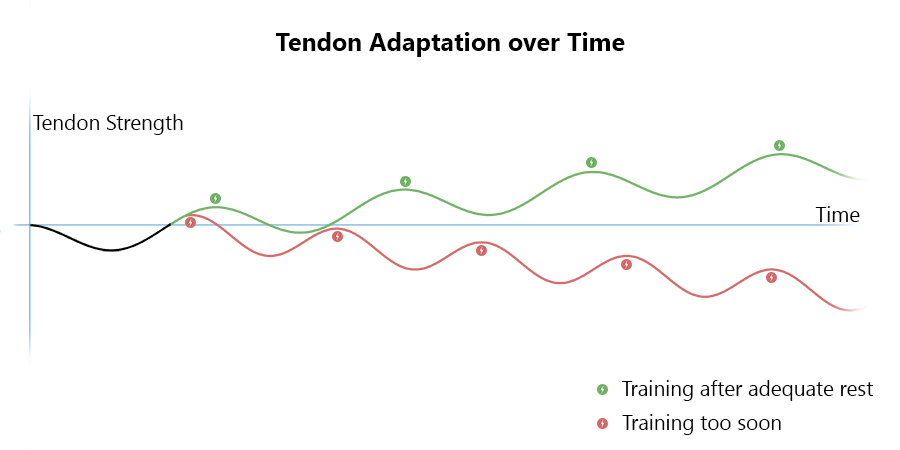
Weaker tendons are more prone to future overuse, thus leading to a vicious cycle that can be hard to escape from.
This explains why ignoring the pain can add months to your recovery time.
Is Patellar Tendonitis Inflammation?
A common misconception is that tendonitis is caused by inflammation3. While inflammation is involved to some degree4, tendonitis is not an inflammatory response, but an injury driven by cellular degradation.
That’s why using anti-inflammatories such as Ibuprofen to treat patellar tendonitis can even be detrimental to the recovery process, as we’ll talk about in a moment.
Aside from your training, patellar tendonitis can also be driven by certain risk factors. These include:
- No gradual return to sports after a rest period of 6+ weeks5
- Older age (odds ratio of 4.209)6
- Diabetes7
- Participation in jumping sports8, especially volleyball9 or basketball10
- High training volume11 (e.g., risk is almost 9-times as high if you’re training more than 20 hours per week12)
- Central adiposity for men and peripheral adiposity for women13
- Abnormal estrogen levels
- Autoimmune or connective tissue diseases15
- Improper jumping mechanics16
- Muscular problems such as tight hamstrings, calves, or quadriceps muscles17
- Having a higher vertical leap18
- Training on hard surfaces19
- Large increases in training volume or intensity20
Diagnosis
To diagnose the injury your doctor will ask about your pain history and the location of the pain. He or she may also perform a combination of manual examinations21 and imaging tests like MRI or ultrasound to rule out other injuries.
Sometimes patellar tendonitis can be difficult to diagnose, as the knee may be painful even though imaging tests show no pathological changes22. Conversely, changes may be present on ultrasound and yet the knee can still be pain-free23.
Patellar Tendonitis Recovery Time
If you follow a safe and effective tendon strengthening program you will notice a pain reduction after about 4 weeks, but complete recovery can take anywhere between 3 months24 and 15 years25.
The sooner you start rehab, the shorter your recovery time will be. This may seem obvious, but a large percentage of people with patellar tendonitis still end up ignoring the pain for months and sometimes even years.
The good news is that pain can still get better even if you had patellar tendonitis for years.
Which Treatments Work?
The list of treatments for patellar tendonitis includes a variety of options. However, only few are supported by strong evidence in academic research. Here’s an overview.
Resting
Resting is a good treatment option in the very early stage of patellar tendonitis, but as soon as you’ve had the pain for more than a few weeks the cellular changes inside the tendon make resting a non-viable option for long-term improvement.
This is a fancy way of saying that resting doesn’t work once tendonitis has become chronic. If you’ve tried it before, the likely outcome was that pain came back once you returned to sports.
If this sounds familiar, you know that you need a different approach.
Painkillers & Anti-Inflammatories
If necessary your doctor may prescribe you pain medication or anti-inflammatories such as Ibuprofen26. Anti-inflammatories can reduce the pain for a short period of time and they’re a good treatment option in the early stages of patellar tendonitis.
However, once the injury has become chronic, non-steroidal anti-inflammatories will slow down your recovery by interfering with tendon repair27.
Physical Therapy Exercises
Treating patellar tendonitis with slow strengthening exercises like leg extensions28, leg presses29, or eccentric squats30 has produce good long-term outcomes in academic research.
Eccentric Squats
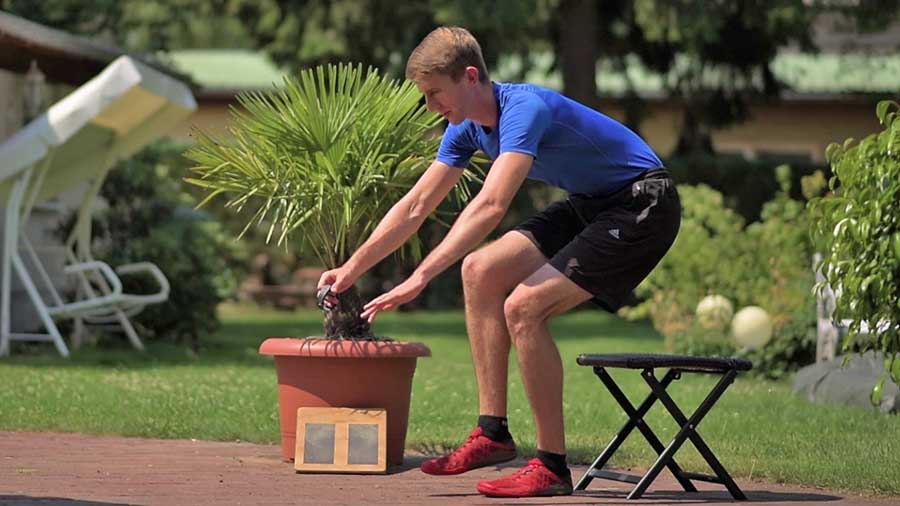
You can do eccentric squats on a slanted board or on flat ground once you’ve progressed to the single-leg version.
The key to success with this exercise is to execute each repetition slowly. Take about 3 seconds on the way down and 3 seconds on the way up. If necessary you can do the eccentric squats to parallel, but ideally you’d do the full range of motion.
Leg Press
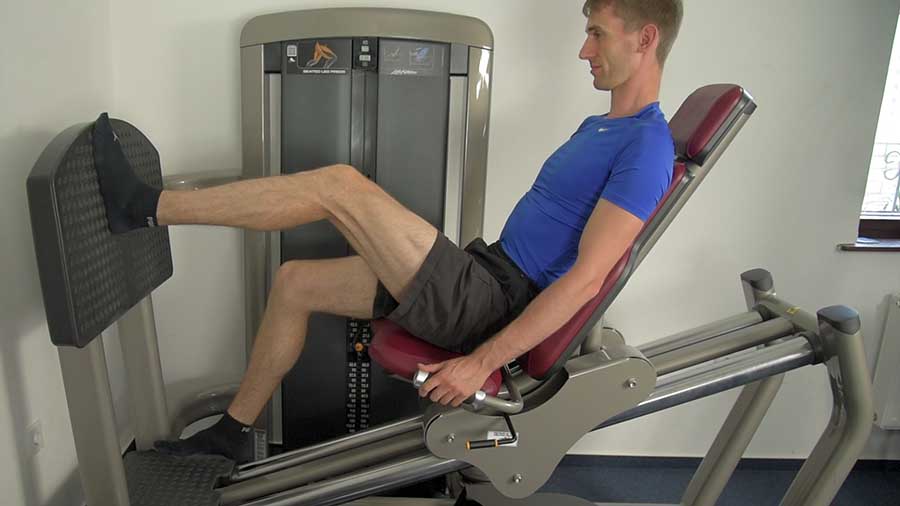
If you have access to a gym, the leg press is a great alternative to the eccentric squat. It offers more granular control over the resistance. This makes progressing easier and also reduces your risk of setbacks.
Leg Extension
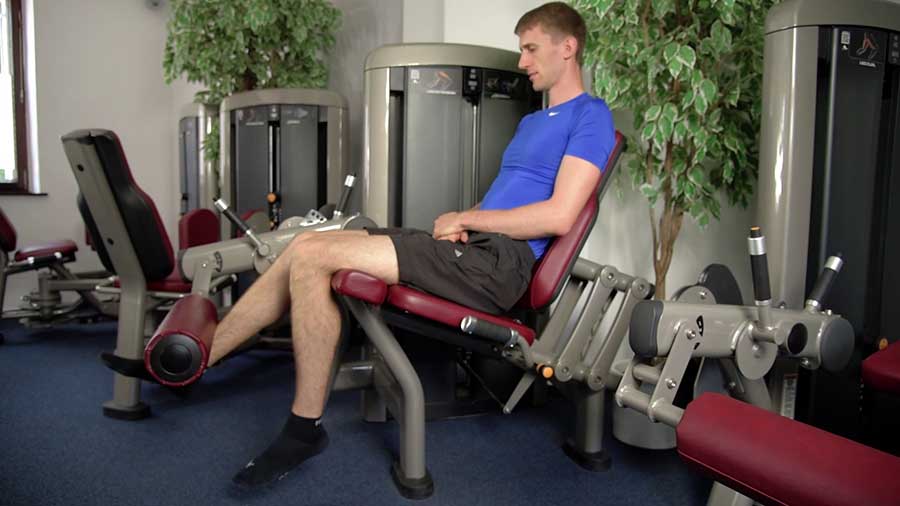
The main benefit of the leg extension machine is that it allows you to detect and correct muscular imbalances between sides through isolation of the quadriceps muscles.
Limit yourself to the middle range of motion or do isometric holds only. To do isometric holds, pick a heavy weight that you can hold with a single leg for about 45 – 60 seconds, push the bar up with both legs, and then hold with one leg.
Spanish Squat
Tendons that are easily irritated can benefit from performing isometric holds in those same exercises. Isometrics have delivered promising results in research because they reduced tendon pain as well as muscular inhibition of the quadriceps muscle31.
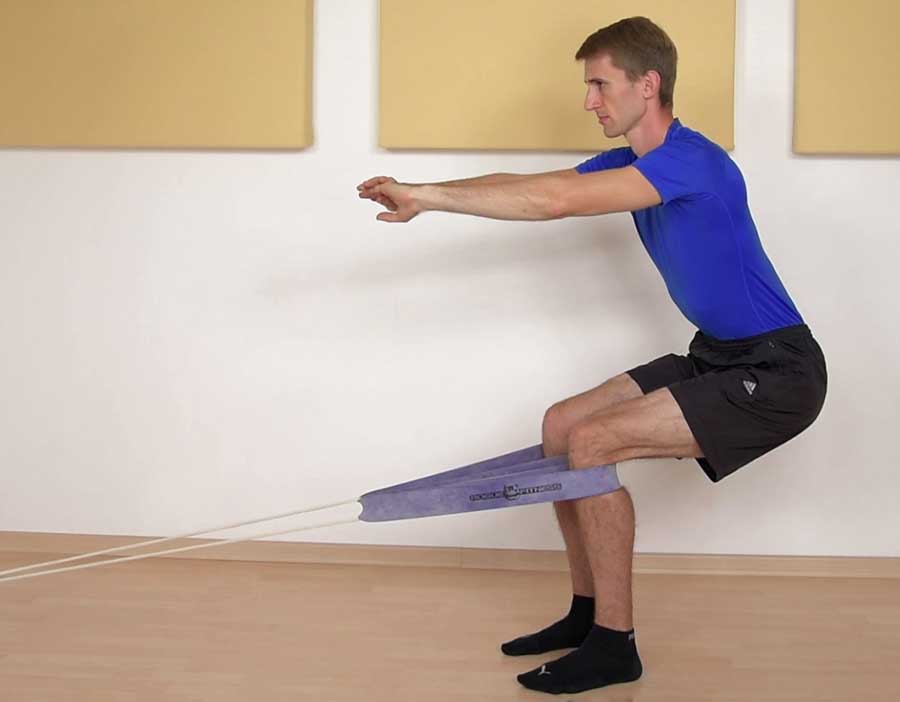
To do the Spanish Squat you need a strong elastic band or a thick strap to pull the top of your calves forward. Now you can squat back while keeping your shins vertical. Try to keep your upper body as vertical as possible.
Once you’re in position you can hold the Spanish squat for time or do slow repetitions.
Stretching Exercises
You can also use stretching exercises, such as hamstring, quadriceps, or calf stretches, to prevent and treat patellar tendonitis32. Here’s a video demonstration of my favorite stretches for jumper’s knee:
These stretches can produce even better treatment outcomes if you combine them with the slow strengthening exercises we talked about earlier, compared to just doing the strengthening drills33.
Be careful with stretching if your tendon is easily irritated. In these cases it’s better to focus on tendon strengthening work until the tendon is strong enough to tolerate stretching without becoming painful.
Please clear all strengthening and stretching exercises with your doctor before starting any exercise regimen.
Other Treatments for Jumper’s Knee
Once jumper’s knee has become chronic, treatment with the strengthening exercises we covered above usually takes months rather than weeks to produce results.
Unfortunately, some people confuse the slow progress these exercises provide with being stuck and since nobody wants to be in pain, the promises some of the other treatment option make seem too enticing to ignore.
However, there is no convincing evidence in academic research that these adjunct treatments provide long-term benefits for tendonitis34. Still, let’s look at them in more detail.
[Treatment collage]
Icing
You can use ice to manage your pain without painkillers or anti-inflammatories. However, icing didn’t show any treatment benefits for patellar tendonitis35 and it temporarily reduced flexibility of the tendon it was used on36.
Ultrasound Therapy
This treatment option provided inconsistent results in some studies37 and even showed no benefits at all in other research38.
Patellar Tendon Straps
Patellar tendon straps can reduce pain for a short period of time for some people with patellar tendonitis39. These straps have also been shown to improve jumping mechanics40 as well as body awareness41. They may also contribute to better patellar tracking42.
Please note that these straps did not improve jumping performance43 or long term treatment outcomes of patellar tendonitis.
Iontophoresis
In iontophoresis an ionizing current is used to drive a substance, usually an NSAID or a corticosteroid, deeper into the treated tissue44. However, when compared to a control group iontophoresis delivered no treatment benefit45.
Invasive Treatments
A number of minimally invasive procedures are available to treat patellar tendonitis. Here’s what I discovered about them in academic research .
“Cortisone” Injections
Cortisone injections are a popular treatment option for patellar tendonitis because they have a low risk of immediate side-effects, are easy to perform, and are inexpensive46.
These injections usually reduce pain for a short period of time, but at the cost of a higher risk of suffering a relapse47. For example, 72% of study participants in a study on elbow tendinopathy suffered a relapse after receiving a cortisone injection48.
Another unwanted side-effect of corticosteroid injections is the increased risk of suffering a tendon tear49, as the injections lead to weaker tendons50.
Prolotherapy & Dry-Needling
These are two other minimally invasive treatment modalities for patellar tendonitis, but I couldn’t find strong evidence to support their use51.
PRP Injections
Another popular treatment option for patellar tendonitis is PRP injections (platelet-rich plasma).
In PRP, centrifuged blood is (re)injected into the injured body part with the intention of restarting or speeding up the healing process.
So far there is little proof that PRP provides a treatment benefit when compared to placebo injections52, but it can still be a beneficial option for recalcitrant cases.
Surgical Intervention
If all other treatment options fail, surgical intervention still stands as a last resort treatment53. Different procedures are available and each comes with different risks and benefits54. Talk to your surgeon if you want to know more about this.
Surgery for patellar tendonitis often requires a longer rehab time of 6 to 12 months55, but long-term improvements of this intervention were promising56. In one study on patellar tendonitis surgery improved the symptoms in 57% of study participants57.
The best thing you can do though is to avoid further tendon damage as soon as you become aware of the injury by not training through pain.
In the majority of cases, an exercise-based approach provides far superior long-term results58, as long as it’s performed correctly. Here’s where I would love to help you.
Footnotes & PDF Download
If you’re looking for the footnotes, you can download the full version of this article here: Patellar Tendonitis & Jumper’s Knee: The 2021 Ultimate Guide PDF.
